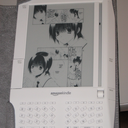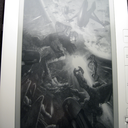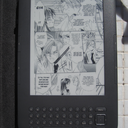74 lines
5.2 KiB
Markdown
74 lines
5.2 KiB
Markdown
# Mangle
|
|
|
|
Mangle is a cross-platform image converter and optimizer built for reading Manga on the Amazon Kindle and other E-ink
|
|
devices written in Python. With this application you can easily:
|
|
|
|
* Sort and organize images from different directories; bulk rename feature exists for output to the Kindle.
|
|
* Optionally re-save images in a format Kindle will be sure to understand with no visible quality loss.
|
|
* Downsample and rotate images for optimal viewing on Kindle, convert to grayscale to save space and improve contrast.
|
|
* Automatically generate book meta-data so that your Manga is always properly detected and viewable in-order.
|
|
|
|
[](https://foosoft.net/projects/mangle/img/kindle1.png)
|
|
[](https://foosoft.net/projects/mangle/img/kindle2.png)
|
|
[](https://foosoft.net/projects/mangle/img/kindle3.png)
|
|
[](https://foosoft.net/projects/mangle/img/kindle4.png)
|
|
|
|
## Motivation
|
|
|
|
Many years ago I received an Amazon Kindle as a gift. I immediately began playing around with it and reading about
|
|
certain undocumented features that the Kindle has to offer. After a couple of hours I discovered it to be the perfect
|
|
device for reading Manga is almost always grayscale, and the aspect ratio fits the Kindle's 600x800 pixel screen almost
|
|
perfectly. Better yet, the Kindle's undocumented image viewer actually keeps track of the last image you viewed and thus
|
|
you are always able to return to the page you left off on when you power on your Kindle. The device supports several
|
|
popular image formats (jpeg, png, gif, etc), and is able to dither and downscale images to fit the screen.
|
|
|
|
However... The Kindle's image viewer does have certain shortcomings:
|
|
|
|
* The Kindle is very picky about file format; any additional embedded data (thumbnails, comments, possibly even EXIF
|
|
data) can confuse it. As a result, images may not display properly or even not at all (which actually prevents you
|
|
from reading the given book, as one bad panel will prevent you from viewing subsequent images).
|
|
* The first image that you view in a Manga (until the Kindle first writes the "bookmark" file) seems to be arbitrary
|
|
even when files are named sequentially. About half the time it will correctly pick the first file in the batch, at
|
|
other times it will pick out some other image seemingly at random.
|
|
* Normally for Kindle to find your Manga scans you have to press <kbd>Alt</kbd> + <kbd>Z</kbd> on the home screen. I
|
|
haven't always had luck with it correctly identifying image directories. At other times, after finding an image
|
|
directory the Kindle will appear to hang while trying to access it (forcing you to return to the home screen).
|
|
* The Kindle image viewer has no functionality to rotate images. So if there is a horizontally large image (such as
|
|
what often happens with dual-page scans), it can be difficult to make out the text because the image is simply
|
|
scaled to fit (consequently leaving a lot of wasted space at the bottom of the screen).
|
|
* Scanlation images are oftentimes much larger than the 600x800 screen; not only does this make them take more space
|
|
on your memory card but it also slows down image loading (the Kindle has to read more data off of the slow SD card
|
|
and scale the image). Scanlations often also include color scans of covers and inserts which take up more space than
|
|
a grayscale equivalent (which is would be fine for the Kindle's limited display).
|
|
* Kindle's image viewer provides no way to sort images (to determine in which order they are shown). This can be very
|
|
problematic especially considering that scanlation groups have differing naming conventions, and as a result files
|
|
from later chapters may appear before earlier ones when you are reading your Manga (spoilers ftl).
|
|
|
|
Mangle was born out of my annoyance with these issues. The program name is a portmanteau of "Manga" and "Kindle"; I
|
|
thought it was pretty clever at the time.
|
|
|
|
## Usage
|
|
|
|
1. Add the desired images and image directories to the current book.
|
|
2. Re-order the images as needed (files pre-sorted alphabetically).
|
|
3. Configure the book title and image processing options.
|
|
4. Create a root-level directory on your Kindle called `pictures` (case sensitive).
|
|
5. Export your images, selecting the `pictures` directory you just created.
|
|
6. Enjoy your Manga (if it doesn't show up, press <kbd>Alt</kbd> + <kbd>Z</kbd> while on the home menu).
|
|
|
|
## Dependencies
|
|
|
|
* [PyQt4](https://riverbankcomputing.com/software/pyqt/download)
|
|
* [Python 2.7](http://www.python.org/download/releases/2.7/)
|
|
* [Pillow (PIL)](https://pypi.org/project/Pillow/)
|
|
* [ReportLab](https://pypi.org/project/reportlab/)
|
|
|
|
## Installation
|
|
|
|
Pre-build binaries are available for the platforms listed below. I don't have the means to make MacOS X releases myself,
|
|
so I am providing the old (and unsupported) package built by Rob White instead. Linux users should run Mangle directly
|
|
from source.
|
|
|
|
* [Windows](https://foosoft.net/projects/mangle/dl/mangle_win.zip)
|
|
* [MacOS X](https://foosoft.net/projects/mangle/dl/mangle_osx.zip)
|